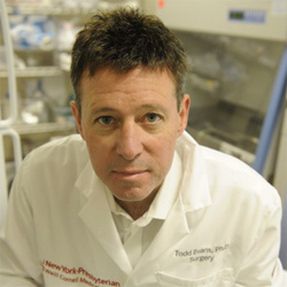Doctors find potential new approach for early detection of myelodysplastic syndromes
A collaboration between researchers at Weill Cornell Medicine, University of Chicago, Albert Einstein College of Medicine, and the University of Oxford has led to a new method to detect earlier stages of myelodysplastic syndromes (MDS), a group of blood cancers characterized by low red blood cell counts.
The research was published Nov. 2 in the Proceedings of the National Academy of Sciences.
About 13,000 patients are diagnosed with MDS each year in the U.S. Early diagnosis is critical for therapeutic intervention because a proportion of patients with MDS develop acute myeloid leukemia (AML), a blood cancer characterized by the abnormal accumulation of white blood cells in the bone marrow, interfering with normal blood cell production.
Todd Evans, Ph.D., the Peter I. Pressman, M.D. Professor in Surgery, led the Weill Cornell team.
Amittha Wickrema, director of the clinical cell therapy laboratory at the University of Chicago Medicine. He focuses his research efforts in studying normal blood cell development and diseases associated with blood cells such as MDS.
“Typically when people think of cancer, they think of having too many cells that grow uncontrollably. Part of having MDS means that you are anemic: that instead of growing too many cells, you’re actually not growing enough, leading to bone marrow failure,” Wickrema said.
The scientists’ new method involves detecting subtle abnormalities in blood cell structures before they develop into the syndromes themselves. Typical diagnoses of MDS are made by performing often-painful bone marrow sampling at more advanced stages of the disease. With the new discovery, however, it is possible that scientists no longer need to wait on the disease to progress and can potentially use a blood sample to identify patients who are genetically predisposed to it through gene mutations.
“Most anemic patients feel lethargic and have a shortness of breath, and that’s when they come in to see a doctor. The severity of the disease depends on the type of mutation/abnormality that exists, and before, we were not able to correlate the mutated genes with the abnormal red blood cells. We can now correlate the abnormalities seen in early red blood cells with mutations in a gene called DOCK4,” Wickrema said.
Dedicator of cytokinesis 4, or DOCK4, is an activator of small G proteins, which can control how cells divide, reorganize their cytoskeleton, and move. Previous work in the field first identified DOCK4 as a gene disrupted in bone cancer models in mice.
Doctors also think that in addition to low blood cell counts and malfunctioned genes, certain inherited genetic conditions, exposure to certain chemicals and heavy metals, and effects from previous cancer treatments with chemotherapy or radiation are what MDS may also develop from. MDS patients are currently treated with medication, chemotherapy and stem cell transplants.
Wickrema and his team hope to further their research and to eventually compare current treatments with newer ones once they are developed and clinically tested.
“This is just the beginning. Now that we know the molecular pathway, we can develop our findings for more robust tests that can accurately diagnose patients,” Wickrema said.
This story first appeared in the The Chicago Maroon.




